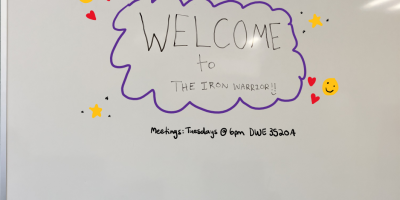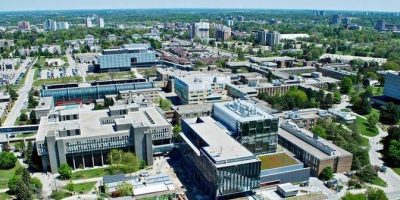Hey everybody, I hope Hell Week went well, or is going well, if you are still in the midst of it. As of writing this editorial I still have one more midterm tomorrow, then one on Thursday. My editorial this issue may end up being kind of preachy and mostly a rant, but here it goes – Driver’s share resposnsibiliy on the road, its not the just the Region’s fault.Most people have probably read or at least heard about the recent roundabout design and safety concerns that have come up in the Record in the last couple weeks. I want to first clarify that I have great sympathy for Cassie Lam, the girl who was hit at the Homer Watson/Block Line roundabout on October 7th. She and her family have a long road ahead of them and will need support from the community and others for many years to come. I think this accident shows that the Region of Waterloo has a long way to go towards the successful implementation of roundabouts, but they are taking the necessary steps and trying to innovate instead of just paving every natural surface on the planet.I personally believe that roundabouts can be much safer than intersections, especially for vehicles, but also for pedestrians if the proper design is implemented and education is in place. One of the biggest benefits of roundabouts is the drastic reduction in head-on and T-bone type collisions, because of the direction of travel and the reduced conflict points. In a roundabout all traffic is circulating in the same direction (hopefully, otherwise those videos from the region aren’t working to well), so most accidents are side-swipes and rear-end collisions resulting from people entering or exiting wrong. Newspapers commonly report the vastly higher number of accidents at roundabouts, blaming the intersection design or the region, but not the drivers. People are inherently resistant to change, also I think there might be a bit of a “why do we need a European solution, our intersections work fine” attitude in a lot of people.Circular intersections have in fact been used in North America in the past, but many were removed because of flaws in the design. This is where some confusion stems from now, as the region is installing roundabouts, not traffic circles or turning circles. The difference between the designs is in their size and priority controls. Traffic or turning circles can be used for small residential interesections as well as large intersections, but they all have a distinct difference from roundabouts – the traffic in the circle has to yield to traffic coming into the circle, or there are also individual priority schemes for some circles. The inherent flaw in this system was that a traffic circle could fill up to capacity, and become completely grid-locked because nobody in the circle can get out as everybody outside the circle is trying to get in. Roundabouts on the other hand give priority to people circulating within the intersection, while people entering have to yield. This ensures (theoretically) that traffic should always keep moving and a roundabout should not become grid-locked. I said theoretically, because a lot of people seem to view yield signs the same way they view amber lights – speed up and try to beat the light. People seem to view the yield sign as meaning ‘go whenever you want, this isn’t a stop, so anything goes’. I think this is why we have so many accidents in roundabouts, people don’t think they need to be taught how to go through them, so they don’t look at the instructional videos. Then they hear about accidents and blame the region for introducing these new-fangled intersections. People cut infront of circulating traffic instead of yielding, they drive through the intersection much higher than the design speed (which is posted), they try to pass other vehicles in the roundabout (which is illegal), and they speed up as they leave to beat the other guy exiting, right as they approach the pedestrian crossing. Wow, no wonder we see so many accidents. Maybe the drivers in Europe really are better than us, they definitely seem to understand priority more.Maybe roundabouts do need to have the pedestrain crossings moved farther away from circular traffic, I don’t know. Maybe drivers need to slow down, respect that pedestrains are people too and have a right to cross the street. People need to realise that the difference between going through the intersection at 20kph above the limit will only gain you a few seconds down the road, but could cost you a lot if you hit another car or a pedestrian. Take your time, learn how to use roundabouts and respect everyone around you, on the road and on off. Hopefully that wasn’t too preachy, see you next isue.
Letter From the Editor: Driver Responsibility in Roundabouts
Note: This article is hosted here for archival purposes only. It does not necessarily represent the values of the Iron Warrior or Waterloo Engineering Society in the present day.
Hey everybody, I hope Hell Week went well, or is going well, if you are still in the midst of it. As of writing this editorial I still have one more midterm tomorrow, then one on Thursday.
My editorial this issue may end up being kind of preachy and mostly a rant, but here it goes – Driver’s share resposnsibiliy on the road, its not the just the Region’s fault.
Most people have probably read or at least heard about the recent roundabout design and safety concerns that have come up in the Record in the last couple weeks. I want to first clarify that I have great sympathy for Cassie Lam, the girl who was hit at the Homer Watson/Block Line roundabout on October 7th. She and her family have a long road ahead of them and will need support from the community and others for many years to come. I think this accident shows that the Region of Waterloo has a long way to go towards the successful implementation of roundabouts, but they are taking the necessary steps and trying to innovate instead of just paving every natural surface on the planet.
I personally believe that roundabouts can be much safer than intersections, especially for vehicles, but also for pedestrians if the proper design is implemented and education is in place. One of the biggest benefits of roundabouts is the drastic reduction in head-on and T-bone type collisions, because of the direction of travel and the reduced conflict points. In a roundabout all traffic is circulating in the same direction (hopefully, otherwise those videos from the region aren’t working to well), so most accidents are side-swipes and rear-end collisions resulting from people entering or exiting wrong. Newspapers commonly report the vastly higher number of accidents at roundabouts, blaming the intersection design or the region, but not the drivers. People are inherently resistant to change, also I think there might be a bit of a “why do we need a European solution, our intersections work fine” attitude in a lot of people.
Circular intersections have in fact been used in North America in the past, but many were removed because of flaws in the design. This is where some confusion stems from now, as the region is installing roundabouts, not traffic circles or turning circles. The difference between the designs is in their size and priority controls. Traffic or turning circles can be used for small residential interesections as well as large intersections, but they all have a distinct difference from roundabouts – the traffic in the circle has to yield to traffic coming into the circle, or there are also individual priority schemes for some circles. The inherent flaw in this system was that a traffic circle could fill up to capacity, and become completely grid-locked because nobody in the circle can get out as everybody outside the circle is trying to get in. Roundabouts on the other hand give priority to people circulating within the intersection, while people entering have to yield. This ensures (theoretically) that traffic should always keep moving and a roundabout should not become grid-locked. I said theoretically, because a lot of people seem to view yield signs the same way they view amber lights – speed up and try to beat the light. People seem to view the yield sign as meaning ‘go whenever you want, this isn’t a stop, so anything goes’. I think this is why we have so many accidents in roundabouts, people don’t think they need to be taught how to go through them, so they don’t look at the instructional videos. Then they hear about accidents and blame the region for introducing these new-fangled intersections. People cut infront of circulating traffic instead of yielding, they drive through the intersection much higher than the design speed (which is posted), they try to pass other vehicles in the roundabout (which is illegal), and they speed up as they leave to beat the other guy exiting, right as they approach the pedestrian crossing. Wow, no wonder we see so many accidents. Maybe the drivers in Europe really are better than us, they definitely seem to understand priority more.
Maybe roundabouts do need to have the pedestrain crossings moved farther away from circular traffic, I don’t know. Maybe drivers need to slow down, respect that pedestrains are people too and have a right to cross the street. People need to realise that the difference between going through the intersection at 20kph above the limit will only gain you a few seconds down the road, but could cost you a lot if you hit another car or a pedestrian. Take your time, learn how to use roundabouts and respect everyone around you, on the road and on off. Hopefully that wasn’t too preachy, see you next isue.




Leave a Reply